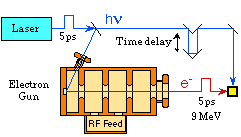BNL Chemistry Department | Photo- and Radiation Chemistry | Group Members
Welcome to the
Brookhaven National Laboratory
Center for Radiation Chemistry Research
 |

|
| LEAF Facility Layout | LEAF System Components | Features of LEAF | LEAF Publications |
Research Highlights from LEAF:
The Center for Radiation Chemistry Research (CRCR) exploits pulse radiolysis techniques to study chemical reactions (and other phenomena) by subjecting samples to pulses of high-energy electrons. The reactions are followed by various methods of time-resolved spectroscopy and other detection techniques. The CRCR includes the new picosecond Laser-Electron Accelerator Facility (LEAF), a 2 MeV Van de Graaff, and a cobalt-60 source.
User access to CRCR facilities is encouraged, either through collaboration with BNL staff or via the BNL Center for Functional Nanomaterials (CFN) User Program. Please contact one of our Principal Investigators or the general facility address (crcr@bnl.gov) for more information.
The design of the LEAF accelerator is innovative: the electron pulse is produced by laser light impinging on a photocathode inside a resonant cavity, radio frequency (RF) gun about 30 cm long. The emitted electrons are accelerated to 9.2 MeV within the length of the gun by ~15 megawatt pulse of RF power from a SLAC-type 2.856 GHz klystron. The laser pulse is synchronized with the RF power to produce the electron pulse near the peak field gradient (about 1 MeV/cm). Thus the pulse length and intensity are a function of the laser pulse properties, and electron pulse lengths as short as 5 picoseconds are attainable.
RF photocathode electron guns of this type have been built at Brookhaven's Accelerator Test Facility and Deep-UV Free Electron Laser Facility as well as at several other laboratories and universities, but almost all of these installations are dedicated to accelerator physics or free electron laser development. The BNL Chemistry Department's LEAF accelerator was the first photocathode gun accelerator in the world to be dedicated to pulse radiolysis studies. Today, there are seven other pulse radiolysis facilities similar to LEAF operating or under construction around the world.
The International Symposium on Ultrafast Accelerators for Pulse Radiolysis was held at the BNL Chemistry Department in June, 2004, to discuss the state-of-the-art in fast pulse radiolysis systems and to find solutions to technical issues faced by these specialized applications. Click on the above link for information about the meeting and links to other facilities (in the Agenda).
The LEAF accelerator system is located in the Augustine O. Allen Laboratories, Rooms 20 - 23 of the Chemistry Building. "Gus" Allen was a pioneer of modern radiation chemistry and the founder of the radiation chemistry program at Brookhaven.
For more information, contact Jim Wishart (wishart@bnl.gov).